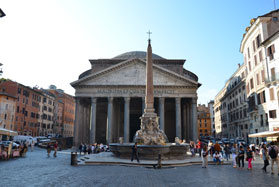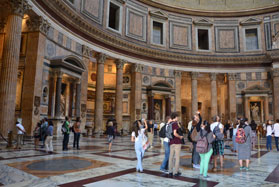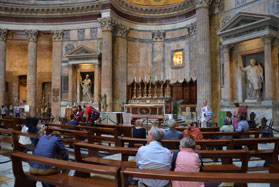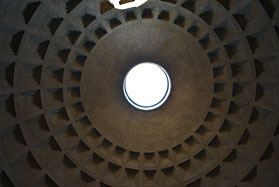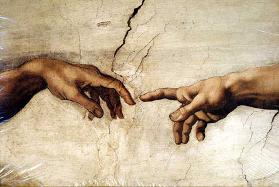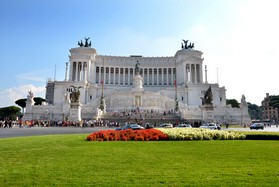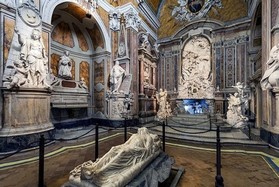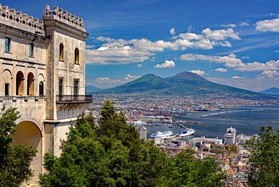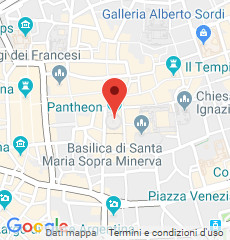Pantheon of Agrippa
A little history of the Pantheon of Agrippa
The Pantheon of Agrippa, also known as the Pantheon of Rome, is one of the masterpieces of architecture present in the Italian capital as well as being the best preserved building of ancient Rome.
The construction of the Pantheon was done in the time of Hadrian, in 126 AD. It receives the name of Agrippa for having been built where previously, in the year 27 AD, was the Pantheon of Agrippa destroyed by a fire in 80 AD. During the beginnings of the 7th century the building was donated to Pope Boniface IV who transformed it into a church preserving for it to this day in perfect condition.
The rectangular facade hides an enormous dome with a diameter greater than the one of the St. Peter's Basilica. It is composed of 16 granite columns 14 meters high, on which the inscription "M.AGRIPPA.LFCOS.TERTIVM.FECIT", which means "Marcus Agrippa, son of Lucius, consul for the third time, built it ".
What is the Pantheon of Agrippa nowadays?
The Pantheon of Agrippa is the best preserved Roman building in the world, it is a perfect synthesis of harmony and constructive intelligence and nobody dared to perform a similar work until the Renaissance, fourteen centuries later. Michelangelo referred to the Pantheon as the building that had "an angelic and not a human design".
Nowadays, this building still retains its original marble pavement and in the inner chapels, where formerly the statues of the divinities were found, today there are chapels with numerous works of art. Since the Renaissance period, the Pantheon has been used as the seat of the Academy of Virtuosos of Rome serving as tomb to great Italians such as Raphael of Urbino and the kings Vittorio Emanuele II, his son Umberto I and his wife Margherita.
Even though the Pantheon is a historical monument, it still remains a church in which masses and especially marriages are celebrated.
Curiosities of the Pantheon of Agrippa
Did you know that the dome of the Pantheon is the largest mass concrete dome in history? This dome has a diameter of 43.44 m, the height in its interior, from floor to ceiling, is equal to the diameter, has a weight of 4535 tons and was also made without a steel armor inside.
Did you know that the eyepiece on the ceiling of the Pantheon lets the rain pass to the great circular room? This eyepiece has a diameter of 9 m and always remains open allowing the entrance of light but also of rain. For this reason the pavement of the circular room is slightly curved, the central part is slightly higher than 30 cm to the perimeter so that the rain goes towards the drainage channel that is all around the perimeter.
Why visit the Pantheon of Agrippa?
The Pantheon of Rome or Pantheon of Agrippa is one of the most impressive masterpieces of architecture of all times and to see it for the first time is really impressive. It is hidden between the narrow streets of the Trevi district, very close to Navona Square. The Pantheon is one of the magnificent buildings in the ancient world and its proportions and structure are representative of the religious conception of the Romans.
It is incredible to think that the Pantheon was already in this place back in 128 AD. and it has seen the life of Rome pass in front of his portico for almost nineteen hundred years. Its impalpable and ghostly appearance contrasts with the buildings and the life that develops around it.
How to visit the Pantheon?
The Pantheon is undoubtedly one of the most famous monuments of Rome, admission is free, but you can also visit it as part of a group visit or book the private guide who can easily combine this visit with a visit to Castel Sant'Angelo, accessible on foot.
Other attractions in the area
The Pantheon is located in the heart of Rome very close to other attractions that, during your visit to the eternal city, are worth visiting. The eternal city breathes history with an infinity of attractions to visit, however you can not miss the following:
The Colosseum, an impressive structure that attracts millions of tourists who visit Rome every year and which has become the symbol of Rome. On the outside of the Colosseum is the imposing Arch of Constantine which is also very beautiful. In addition, at certain times of the year it is possible to visit the Colosseum at night.
A short distance from the Roman Colosseum is the Domus Aurea (meaning the “golden house” in Latin), a wonderful palace built by Emperor Nero after the great fire of the year 64. According to several calculations, it occupied about 50 hectares between the hills of the Palatine and the Esquiline. It is said that among its luxuries included incrustations of gold, precious stones and ivory.
You may be interested in:
Florence Museum Tickets, Secret Itineraries Tour (Venice) or some Tours in Milan.
Customers who have seen this museum also viewed:
Useful Information
From Monday to Saturday from 9:00 am to 7:30 pm
Sunday from 9:00 am to 6:00 pm
Last admission: 15 minutes before closing
Closed on December 25th, January 1st
Discover the most suggestive museums of Rome:

+39 055713655
Reach the museums in total comfort with our transfer service!

TRANSFER SERVICE
book now




